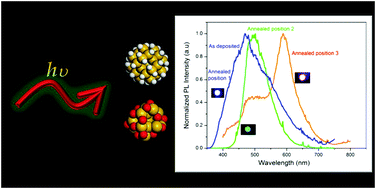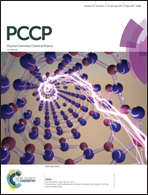Surface chemistry and density distribution influence on visible luminescence of silicon quantum dots: an experimental and theoretical approach†‡
Abstract
The impact of the surface reconstruction of the density distribution and photoluminescence of silicon quantum dots (QDs) embedded in a silicon oxide matrix (SiOx) has been studied. Annealing treatments carried out on the as-deposited samples provoked the effusion of hydrogen species. Moreover, depending on the surrounding density and coalescence of QDs, they resulted in a change in the average size of the particles depending on the initial local environment. The shift in the luminescence spectra all over the visible region (blue, green and red) shows a strong dependence on the resultant change in the size and/or the passivation environment of QDs. Density functional theoretical (DFT) calculations support this fact and explain the possible electronic transitions (HOMO–LUMO gap) involved. Passivation in the presence of oxygen species lowers the band gap of Si29 and Si35 nanoclusters up to 1.7 eV, whereas, surface passivation in the environment of hydrogen species increases the band gap up to 4.4 eV. These results show a good agreement with the quantum confinement model described in this work and explain the shift in the luminescence all over the visible region. The results reported here offer vital insight into the mechanism of emission from silicon quantum dots which has been one of the most debated topics in the last two decades. QDs with multiple size distribution in different local environments (band gap) observed in this work could be used for the fabrication of light emission diodes (LEDs) or shift-conversion thin films in third generation efficient tandem solar cells for the maximum absorption of the solar spectrum in different wavelength regions.



 Please wait while we load your content...
Please wait while we load your content...